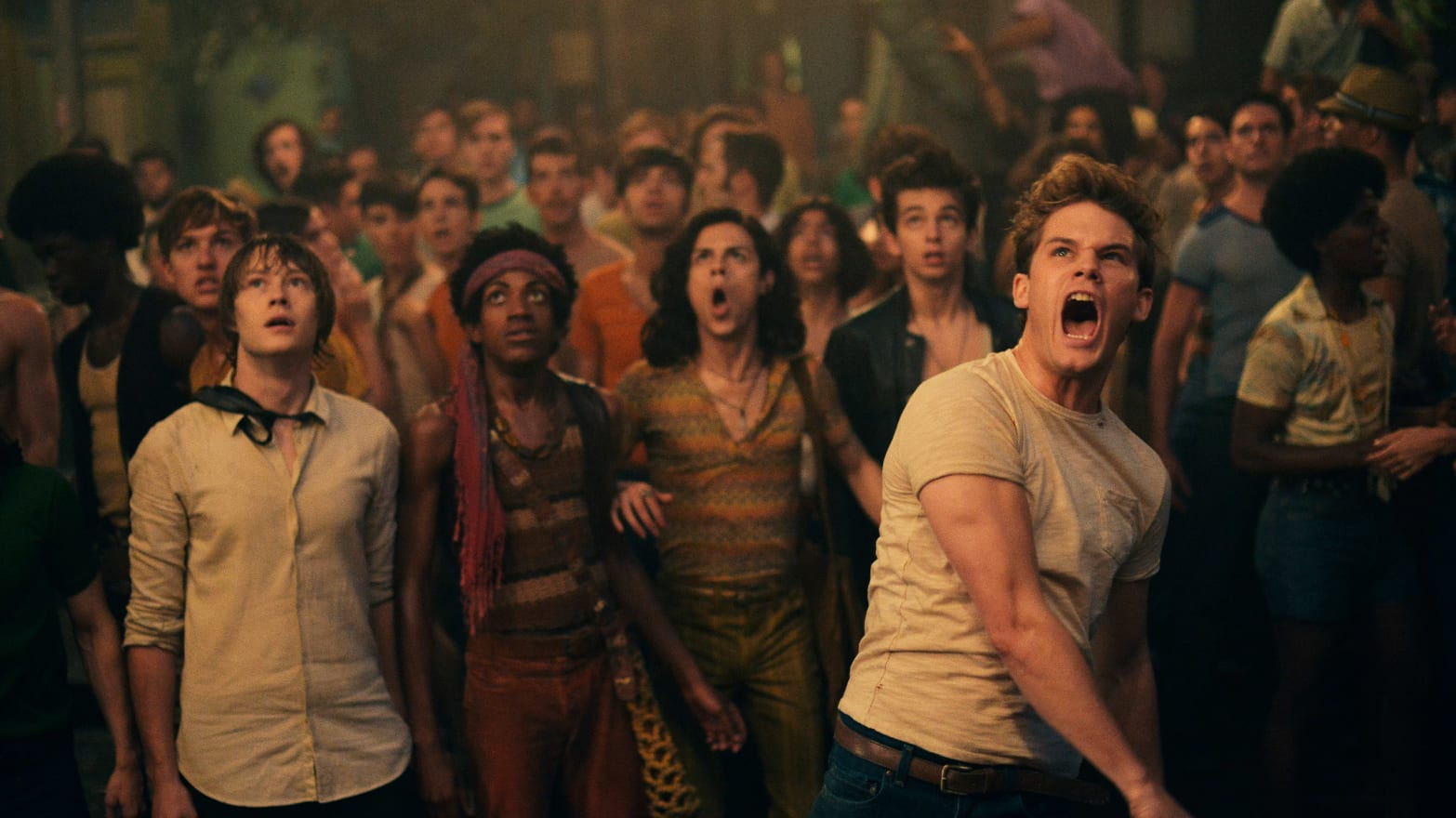The biggest problem of Roland Emmerich’s Stonewall, in a movie freighted with big problems, is that it doesn’t ring true. The story and characters don’t draw you in, or convince you. You aren't made to care.
The longer you sit there—and at two-and-a-half-plus hours, make sure you visit the restroom before taking your seat—the more the absurdity and predictability of Emmerich’s movie, released Friday, slaps you in the face like a sodden cloth, over and over again.
Whatever else it should be, a big-screen movie about the contemporary landmark of the LGBT civil rights movement shouldn’t be this lackluster.
This isn’t yet another cri de coeur from those who watched the trailer last month and condemned it for a literal whitewashing of history; of marginalizing transvestites, transgender people, and black and Latino faces from the events of that night.
The trailer, as it turns out, told the truth: the film’s focus—just as an earlier Stonewall movie of 1995—is a hot, white twink. That doesn’t mean black, Latino or trans characters are missing. They are present and simply secondary. If it is a meager consolation, the movie’s flaws—character, plot, direction—are more significant and damning, and affect everyone equally.
Nothing surprises you about Stonewall: oh wait, a villainous, abusive, obese transvestite in a red satin dress, with jowls that almost hit the floor, surprises you. Like a lot of people in the movie he wants to use and abuse Danny, our hero.
Otherwise, this movie is gay-movie-by-numbers.
It feels panicked into sandwiching in every possible gay theme or storyline into its confused carcass, but you know its trajectory and detail from the very first moment its cutie-pie lead stares forlornly out of the window of the bus bringing him into Nu Yawkk Ciddee.
If it helps lower your expectations, it should be emphasized that despite Emmerich’s well-mounted, Les Miz theatrics of the Riots themselves, Stonewall isn’t about the 1969 Riots in Greenwich Village outside the bar of the same name that still stands there.
Instead, it’s the most traditional, familiar of LGBT movies—the coming out story of Danny (always called Danny; nice, simple, blue-eyed name), a white pretty boy from Indiana, played pallidly by Jeremy Irvine with lips stung by a thousand bees, yearning eyes, ruffled hair, suspiciously modern pecs and biceps, and a tight white T-shirt.
What else does a boy from the Sticks, landing fresh on Christopher Street, need?
The Stonewall Riots are secondary to Danny’s story—even though his coming out, and arriving into himself, is presumably the intended symbolic echo to the ‘coming out’ symbolized by the Riots.
Emmerich is just as intent on getting right the many shots of Danny’s tighty whities than he is on bricks smashing windows, and earnest political speeches. If a movie about gay history is going to feature Frank Kameny, as Stonewall does, then he really deserves more than a moment of screen time.
Kameny, fired in 1957 from his job as an astronomer in the U.S. Army’s Map Service for being gay, was the first gay person to appeal his or her dismissal on the grounds of their sexuality in the courts. He went on to be the inspiring godfather of contemporary gay liberation, and died in October 2011, aged 86.
Read about Kameny’s astonishing life—out at a time when few were; gays in the closet and scared would call him at home just to talk. Kameny would be a fascinating subject for a film. Here, he is reduced to a walk-on character cameo, because our cutie-pie wants to be an astronomer too. The film’s laissez-faire treatment of him is an insult to Kameny’s memory, bravery, and importance.
Instead, we follow dreary, handsome Danny, the action switching between Greenwich Village, and what took place in Indiana, every moment of which you’ve seen before in other movies or TV shows. Danny and the high school football jock have a secret love affair which is uncovered, Danny’s father (David Cubitt) is also the high school football coach and a with-holding homophobe; his mother clutches her hands together and looks pained; his little sister is totally cool and rad, and played well by Joey King.
The characters in the film are all types—hard dad, worried mum, cool sister, closeted buddy—rather than fleshed-out individuals.
In the city, Danny hooks up with Ray (Jonny Beauchamp), a transvestite hustler who hopelessly falls for him, as everyone does of course. But their relationship always feels one-sided, and stays there: Ray loves Danny, Danny doesn’t feel the same way, they fight, they make up. They help and save each other, but they are no Thelma and Louise: you don’t sit there, rooting for them to be together even as friends. One recurring absurdity is that Danny is looking for Ray, or Ray for Danny, yet their gang seems to hang out on the same stoop or same patch of Christopher Street, making any such quest pretty easy surely.
Emmerich has said his focus is LGBT youth homelessness—still a very pressing issue—but the fact that Danny is heading to Columbia University in a matter of months makes his sojourn in the rough streets never feel anything less than temporary.
And yes, there is a question about whether Danny will get into Columbia, but it never feels that perilous. Of course he will. The look of pain on his face when told he must go to night classes is, unintentionally, deliciously funny.
Danny occasionally has sex for money and looks pained, and is beaten by an evil, moustachioed policeman when he chances upon the orgies that used to happen in around the trucks of the Meatpacking District.
In Stonewall, sex is never a pleasure, and always a pain or route to sooner-or-later misery, and violence and abuse is a heartbeat away. It’s an oddly sad, self-hating film despite the occasional gentle and assured character, and the cries of “Gay Power” when the Riots get underway.
Ray tells Danny he doesn’t know of one dream that comes true on Christopher Street, but what dreams does Danny have: we don’t sense he is looking for love exactly. He just seems to be always angry, sad, and pouting—and this, despite having half of New York wanting to either buy him a drink, give him a meal, or jump his bones.
The presence of former pro wrestler Ed Murphy (played appropriately scarily by Ron Perlman), a ruthless pimp and here styled as Greenwich Village’s Fagin, kidnapping and selling boys, adds more menace. The extent of Murphy’s alleged crimes, and his later-conferred hero status, would make yet another fascinating movie.
It’s strange to see the Mattachine Society painted by Stonewall as somehow lacking: sure, they believed in quiet lobbying, dressed in suits, as opposed to Molotov cocktails. But they were hardly the besuited dorks as presented in Stonewall, but rather incredibly brave.
Jonathan Rhys Meyers plays Trevor, one of their number, who falls for Danny, but of course is a cheat, as well as preferring peaceful protest over loud. The fact Trevor puts the hippy-dippy ‘Whiter Shade of Pale’ on the Stonewall jukebox, as opposed to Ray’s choice of the dramatic ‘Venus’ is a neat, acerbic touch—if only the film had more of them.
To be fair to Emmerich, whatever the internet rage mob insists to the contrary, there are conflicting historical narratives to this day on what happened that night (the bar’s own version is here). The trans activist Sylvia Rivera herself once noted that there were not many trans or cross-dressing people at the bar—although another trans activist, Marsha P. Johnson (whose character features in the film, again too glancingly, played by Otoja Abit), claimed Rivera wasn’t there the night of the Riots.
To criticize Emmerich’s grasp of history in totality would be unfair: he evokes accurately that those arrested in bars like the Stonewall at the time were done so because of the law of the time which stipulated that women were required to wear three pieces of feminine clothing and would be arrested if not.
Emmerich, and screenwriter Jon Robin Baitz, have also read the accounts of the unfolding first major night of rioting: the film features Seymour Pine, the commanding officer who launched the raid on the bar that night. He is shown somewhat sympathetically, compared to the other villainous officers.
The movie evokes one key moment mentioned by witnesses: a lesbian, three times escaping the clutches of cops as they try to bundle her into a squad car, bellows at the mainly male crowd watching to do something. This lesbian has no known name (some claim it was Storme deLarverie, another person begging for a movie to be made about her), and she is the only lesbian character of any significance in the movie.
A better movie might be, Who Actually Was At The Stonewall Riots?
To be fair to Emmerich, at the moment of rioting, he makes clear—with the exception that it is Danny who throws the first brick through one of the bar’s windows—that it is the street kids, hustlers, drag queens and trans people who are on the frontline, taking on the bullying police. This too echoes much testimony from the night.
The movie returns, in brief captions, to its real-life inspirations in the final reel, and indeed dedicates itself to Stonewall’s “unsung heroes”—but its main body does not do these “unsung heroes” justice. It feels like a cosmetic memorialization. However, adherence to facts and the highways and byways of identity politics matter less than what a weird mess this film is.
Of course, post-Riots, Danny goes back to Indiana—to play out another series of totally predictable scenes with family, and the closeted jock; and of course he goes back to the Village a year later, looking creepily young Liberace-ish, to reassure his street-dwelling buddies he still loves them. The scenes feel like afterthoughts: if you never bought into the relationships in the first place, the payoff feels empty. You may snuffle, as this viewer did, at one final scene, as Danny marches in the first New York Pride parade of 1970. That’s OK: you can also count your tears as relief your ordeal is almost over.
What Stonewall might most usefully mark is a watershed of its own—a watershed in gay-themed film-making.
The temptation of the coming out film, featuring a wide-eyed pretty young white man, is obvious: this is the story that directors and studios think the mainstream can bear to watch. But, as Stonewall unintentionally shows, the more interesting characters are there on the edges.
If the Stonewall Riots radicalized politics and culture—and their echo is still present, it is now an official New York landmark—then let this listless film be its own wake-up call for writers, directors, and mainstream cinema to mine the true variety of LGBT lives.

